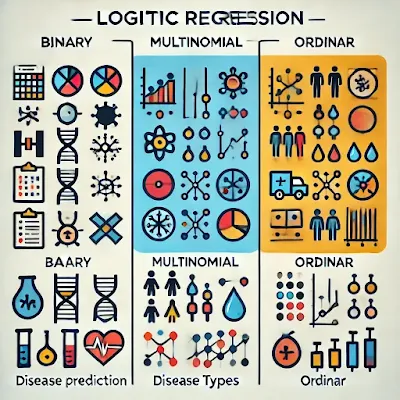 |
| binary, multinomial, and ordinal logistic regression |
1. Binary Logistic Regression
Definition:
- Predicts a binary outcome (two categories).
- Example: Disease (Yes = 1, No = 0).
Equation:
 |
where 𝑝 is the probability of the outcome occurring.
Biological Example:
- Disease prediction (sick or healthy).
- Gene expression (expressed or not expressed).
- Treatment response (responsive or non-responsive).
Use Case:
- Understanding risk factors for diseases.
- Predicting mortality (survived or died) in clinical trials.
2. Multinomial Logistic Regression
Definition:
Predicts an outcome with three or more categories that are not ordered.
Example: Blood type (A, B, AB, O).
Equation:
for 𝐾 categories.
Biological Example:
- Disease type classification (Type I, Type II, or Type III).
- Cell differentiation stages (Progenitor, Differentiated, Specialized).
- Infection strain types (Bacterial, Viral, Fungal).
Use Case:
- Classifying patients into different disease subtypes.
- Identifying the stage of cancer progression.
3. Ordinal Logistic Regression
Definition:
- Predicts an outcome with three or more categories that are ordered.
- Example: Pain level (Mild, Moderate, Severe).
Equation:
where 𝑗 is the threshold for ordered levels.
Biological Example:
- Severity of disease (No, Mild, Severe).
- Tumor grading (Grade I, II, III).
- Drug side effect intensity (None, Mild, Severe).
Use Case:
- Predicting progression stages of a disease.
- Assessing levels of pain in patients during clinical trials.
Choosing the Right Model:
Binary Logistic Regression:
- For simple yes/no outcomes.
- Example: Presence or absence of cancer.
Multinomial Logistic Regression:
- For categorical outcomes with no inherent order.
- Example: Different viral strains in patients.
Ordinal Logistic Regression:
- For ranked outcomes with meaningful order.
- Example: Stages of fibrosis or inflammation.
Tags:
Bio Statistics


.png)